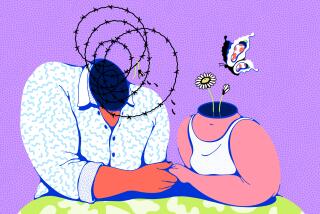Love, Lust and Homo Sapiens
Are women less desirable to men if they are high achievers at work? Do men prefer the âstep and fetch itâ subservient woman to the one with career aspirations? Two studies receiving major media attention say that the answer is yes. Not surprisingly, this âbad news for smart womenâ scenario fueled headlines.
âTheyâre Too Smart for These Guys,â the Chicago Tribune declared. âGlass Ceilings at Altar as Well as Boardroom,â the New York Times announced.
Columnist Maureen Dowd, picking up on the studies, asked whether the feminist movement was âsome sort of cruel hoax,â writing that âthe more women achieve, the less desirable they are.â
In truth, the evidence for this notion is flimsy -- ambiguous questions put to tiny sample groups including, in one study, 18- and 19-year-old men with little workplace experience. And yet this latest theory about male-female relationships already seems to have become part of a new conventional wisdom. Gone is loveâs rapturous âold black magic.â The replacement theory posited by evolutionary psychology holds that the human mating ritual is driven by a collection of hard-wired instincts and impulses that nature has parceled out to males and females in proportions largely relating to species survival.
Among evolutionary psychologyâs truisms:
* Women are by nature coy, modest and monogamous.
* Women with many partners are unnatural, while men are inherently promiscuous. Natural selection instructs men to âspread their seedâ widely.
* Women want successful men to provide for them, and older men generally have more resources than younger men. Women would run right past Brad Pitt if he was a struggling actor instead of a rich and famous one, and fall into the arms of a gray-haired but wealthy swain.
* Men lust after very young, baby-faced, presumably fertile women. University of Texas psychologist Davis Buss makes this claim in âThe Evolution of Desire,â and pop culture revels in this notion.
Thereâs a simple appeal to this worldview, as demonstrated by the mainstream mediaâs salivation at such âevidenceâ as CEO Jack Welch cheating on his second wife with a younger editor at the Harvard Business Review. Unfortunately for this theory, new research suggests that evolution casts males and females far less stereotypically than the evolutionary psychologists imagine.
Take the notion of the monogamous female and the promiscuous male. This pattern is supposed to be typical for both human and nonhuman primates. But field studies of nonhuman primates suggest that natural selection drives female primates to seek many male partners, argues primatologist Sarah Blaffer Hrdy, author of âMother Nature.â In one group of female chimpanzees in West Africa, half of the offspring turned out not to have been sired by the males in residence.
Rather than wait for her evolutionary Prince Charming, what if the supposedly coy female best protects her genetic future by seeking out a whole pride of Charmings? A mother could indeed gain an advantage by copulating with many males, who would then be invested in her offspring. This behavior might prevent males from attacking her babies, or might elicit other forms of protection from a group of males rather than from just one, as males generally are disinclined to kill infants of their species to which they have any kind of connection.
Following a similar line of skepticism, Brown University biologist Anne Fausto-Sterling wonders why some of her scientific colleagues assume that promiscuous human males who spread their seed are the important evolutionary players. Isnât it just as likely, she asks, that the females âwere the ones who hedged their bets and slept with more than one male?â
And does a male have to move from female to female, siring as many children as possible, to ensure that his genes will survive? Do men have love-em-and-leave-em genes? Scientists now suggest that sticking around is a better strategy for human males. After all, because the human female does not go into estrus (heat), the roving male may miss the two or three days a month sheâs fertile. Even if sheâs ovulating, thereâs only about a 20% chance that he will impregnate her. If he does, and heâs soon off to greener pastures, he wonât be around to protect his offspring.
The prehistoric world was a tough one for infants. If a male invested no energy in feeding and guarding his young, there was a good chance that none would survive. Perhaps, as Nicholas Blurton Jones, a UCLA anthropology and psychiatry professor, argues, marriage was invented by human males as a form of âmate-guarding.â Having regular sex with one woman was a lot easier than roaming from female to female, and possibly more effective in terms of reproductive success. So maybe marriage works better than Don Juanism in making men winners in the genetic lottery.
What about the notion that men seek out very young, presumably fertile women? Many economists have noted that in these days when menâs wages are flat or stagnant, their mating strategies are changing. More often they seek a woman who has completed her education. In fact, today, the more education a woman has, the more marriageable she is. Forty percent of married women earn more than their husbands, and studies show their marriages are as happy -- and at least as stable -- as those in which the male is the major breadwinner.
Men indeed do like good-looking women, but they donât have to be very young. In one experiment, when men were shown pictures of plain women in their 20s and more attractive women in their 30s and 40s, the men chose the good-looking older women. However, for men, beauty is not the prime ingredient in a mate. A worldwide study found that for both men and women, âkind and understandingâ were the most sought-after traits in a mate.
And do women set their caps for older, wealthy men? No. In societies with a high degree of gender equality, where women have their own resources, they seek out men who are caring and able to bond with children, report psychologists Alice Eagly of Northwestern and Wendy Wood of Duke. In truth, what men and women look for most in a mate may simply be someone like themselves.
Cornell University biologist Stephen T. Emlen reported in 2003 that âattractive people tend to value attractiveness, wealthy people value mates with money and ambitious types and family-oriented souls tend to gravitate to others like themselves.â The desire for similar mates was five or six times more powerful than the desire for beautiful or wealthy ones.
So what should we make of this landslide of evidence against the ultra-Darwiniansâ belief that mating is driven by rigid patterns of programmed sexual behavior? That we are more than puppets dancing to a preset tune. And perhaps âthat old black magicâ is as good a way as any to understand how and why we love.






